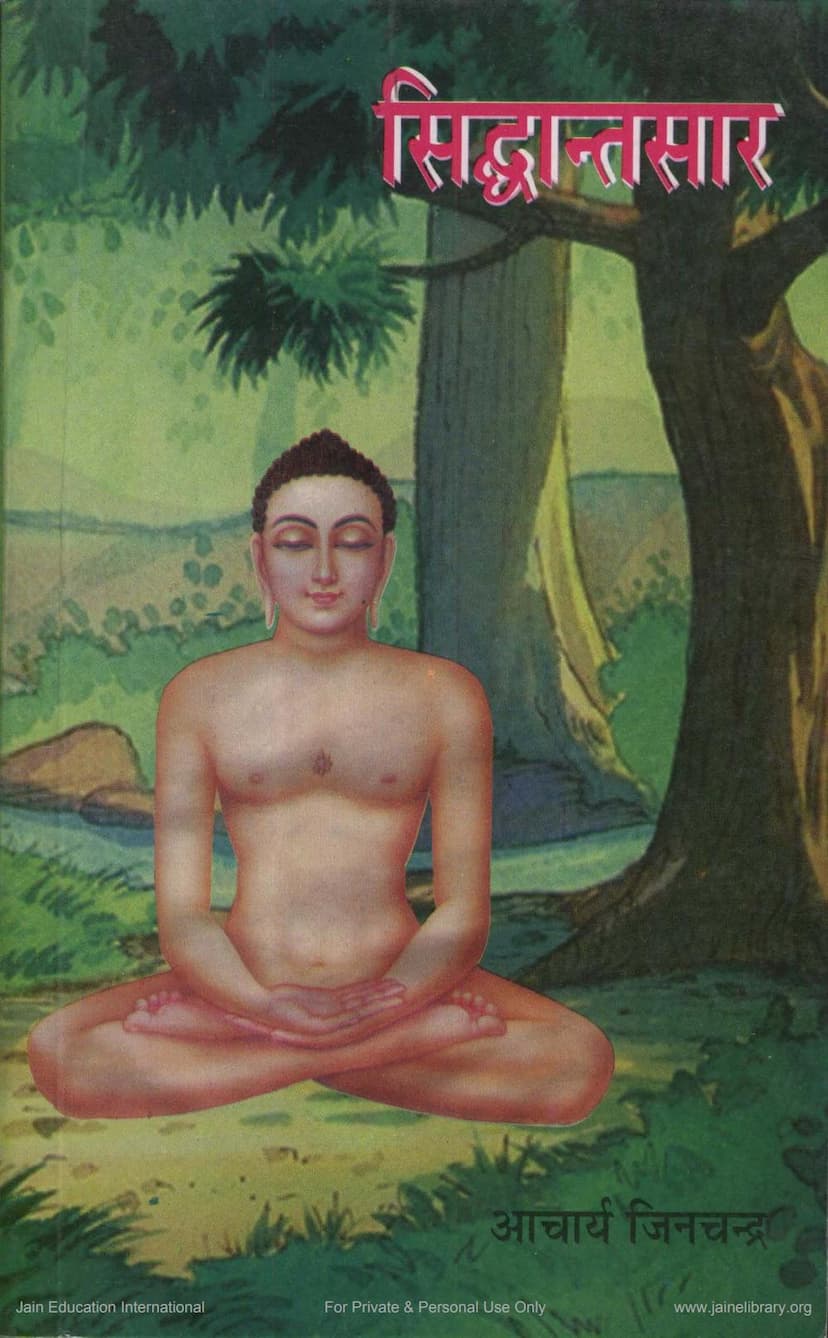Siddhantasara
Added to library: September 2, 2025

Summary
Here's a comprehensive summary of the Jain text "Siddhantasara" by Acharya Jinchandra, based on the provided pages:
Book Title: Siddhantasara Author: Acharya Jinchandra Commentary/Bhashya: Bhattarak Gyanbhushan Translator/Editor: Brahmachari Vinod Kumar Jain, Brahmachari Anil Kumar Jain Publisher: Shri Digambar Sahitya Prakashan, Barela, Jabalpur (M.P.) Publication Date: First Edition, October 1998
Overall Purpose and Content:
"Siddhantasara" is a fundamental Jain text that aims to provide a concise yet comprehensive overview of key Jain philosophical concepts. It falls under the category of Karananuyoga, which deals with the causal aspect of the path to liberation. Specifically, it focuses on the intricate details of various margas (ways or paths of classification) in Jainism.
Key Themes and Structure:
The book systematically analyzes the intricate relationships between different Jain classifications within the context of the fourteen margas. The primary focus is on elucidating:
- Jiva Samasa (Categories of Souls): The text delves into the different types of souls as they manifest within each marga.
- Gunasthana (Stages of Spiritual Progress): It explains which of the fourteen gunasthanas are relevant or present within each marga.
- Yoga (Mental, Verbal, and Bodily Activities): The book details the types of yogas that are associated with souls in different margas.
- Upayoga (Modes of Consciousness/Activity): It clarifies the specific upayogas (like different types of perception and knowledge) that occur within each marga.
- Asrava (Influx of Karma): The text identifies and enumerates the various factors that contribute to the influx of karmic particles in relation to each marga.
Detailed Breakdown of Margas and their Analysis:
The "Siddhantasara" meticulously examines fourteen principal margas, systematically explaining the presence and characteristics of Jiva Samasa, Gunasthana, Yoga, Upayoga, and Asrava within each. These margas are broadly categorized as:
- Gati Margas (Paths of Movement):
- Naraka (Hellish beings)
- Tiriyancha (Animals)
- Manushya (Humans)
- Deva (Celestial beings)
- Indriya Margas (Paths of Sense Organs):
- Ekendriya (One-sensed beings)
- Dvi-indriya (Two-sensed beings)
- Tri-indriya (Three-sensed beings)
- Chatur-indriya (Four-sensed beings)
- Panch-indriya (Five-sensed beings)
- Kaya Margas (Paths of Bodies):
- Prithvi-kaya (Earth-bodied beings)
- Ap-kaya (Water-bodied beings)
- Tejas-kaya (Fire-bodied beings)
- Vayu-kaya (Air-bodied beings)
- Vanaspati-kaya (Plant-bodied beings)
- Trasa-kaya (Mobile beings)
- Yoga Margas (Paths of Activities):
- Manovachana Yoga (Mental and Verbal activities)
- Audarika Kaya Yoga (Physical body activity)
- Audarika Mishra Kaya Yoga (Mixed physical body activity)
- Vaikriyika Kaya Yoga (Ethereal body activity)
- Vaikriyika Mishra Kaya Yoga (Mixed ethereal body activity)
- Aharaka Kaya Yoga (Auspicious subtle body activity)
- Aharaka Mishra Kaya Yoga (Mixed auspicious subtle body activity)
- Karmana Kaya Yoga (Karmic body activity)
- Veda Margas (Paths of Sex):
- Pum-veda (Male sex)
- Stri-veda (Female sex)
- Napumsaka-veda (Neuter sex)
- Kashaya Margas (Paths of Passions):
- Krodha (Anger)
- Mana (Pride)
- Maya (Deceit)
- Lobha (Greed)
- Jnana Margas (Paths of Knowledge):
- Mati-jnana (Sensory and intellectual knowledge)
- Shruta-jnana (Scriptural knowledge)
- Avadhi-jnana (Clairvoyance)
- Manah-paryaya-jnana (Telepathy)
- Kevala-jnana (Omniscience)
- Also covers the negative states: Kumatil-kuta-kuta (Mis-knowledge).
- Samyama Margas (Paths of Restraint):
- Asamyama (Non-restraint)
- Samayika (Initial restraint)
- Chhedopasthapana (Restraint through expiation)
- Parihara-vishuddhi (Restraint through purification)
- Sukshma-samparaya (Subtle delusion)
- Yathakhyata (True conduct)
- Also covers: Desha-samyama (Partial restraint).
- Darshana Margas (Paths of Perception):
- Chakshu-darshana (Visual perception)
- Achakshu-darshana (Non-visual perception)
- Avadhi-darshana (Limited clairvoyance)
- Kevala-darshana (Omniscience)
- Leshya Margas (Paths of Karmic Aura):
- Krishna (Black)
- Neela (Blue)
- Kapota (Grey)
- Tejas (Yellow)
- Padma (Red)
- Shukla (White)
- Bhavyatva Margas (Paths of Aptitude for Liberation):
- Bhavya (Capable of liberation)
- Abhavya (Incapable of liberation)
- Sanjna Margas (Paths of Consciousness/Impulse):
- Sanjnin (Conscious beings)
- Asanjnin (Unconscious beings)
- Ahara Margas (Paths of Nutrition):
- Ahara (With sustenance)
- Anahara (Without sustenance)
Notable Points and Discrepancies Discussed:
The editors and commentators (especially Bhattarak Gyanbhushan) highlight certain points where the "Siddhantasara" presents views that might differ from other prominent Jain scriptures like the Dhavala commentaries. These discussions are crucial for understanding the nuances of Jain doctrine and the specific interpretations offered by Acharya Jinchandra. Examples include:
- Gatha 26: The acceptance of Audarika Kaya Yoga along with Karmic Kaya Yoga in the state of Pratar Samudghata.
- Gatha 36: The exclusion of Chakshu-darshana in Karmic Kaya Yoga and Audarika Mishra Kaya Yoga, contrasting with the Dhavala.
- Gatha 36: The affirmation of ten Upayogas in Chakshu and Achakshu Darshana, while Dhavala accepts eight.
- Gatha 42: The denial of Chakshu-darshana in anaharak (non-nourished) beings, contrary to Dhavala's acceptance of ten upayogas.
Author and Commentator Introduction:
The text includes introductions to the original author, Acharya Jinchandra, acknowledging the existence of multiple acharyas with the same name and suggesting a possible lineage. It also provides biographical information about Bhattarak Gyanbhushan, the commentator, establishing his belonging to a specific monastic lineage (Nandisangha, Balatkaragana, Sarasvatigachchha) and his estimated time period (around 15th century Vikram Samvat).
Overall Significance:
"Siddhantasara" is a valuable resource for scholars and practitioners of Jainism, particularly for those seeking a systematic understanding of the complex interrelationships within the Jain classification system. Its detailed analysis of the margas provides a framework for comprehending the multifaceted nature of sentient existence and the spiritual journey towards liberation. The inclusion of the commentary by Bhattarak Gyanbhushan and the translator's notes adds layers of interpretation and comparative analysis, making it a rich academic and devotional text.